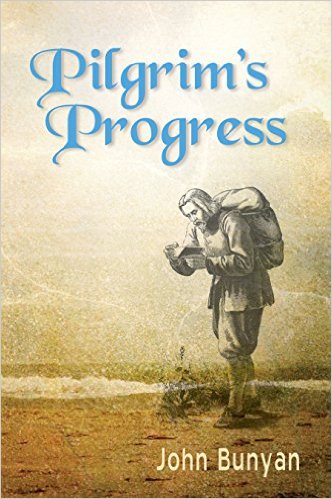 Have you ever heard of an allegory? I haven’t, until this book was delivered courtesy of my much beloved Amazon Prime free two-day shipping. Reading Pilgrim’s Progress couldn’t have been more timely for me, as I could relate to the struggles depicted in the story, finding comfort, solace, and encouragement between its pages. Author John Bunyan adeptly puts biblical truths and moral rationale into organized trains of fictional thought—and the result is nothing short of magnificent.
Have you ever heard of an allegory? I haven’t, until this book was delivered courtesy of my much beloved Amazon Prime free two-day shipping. Reading Pilgrim’s Progress couldn’t have been more timely for me, as I could relate to the struggles depicted in the story, finding comfort, solace, and encouragement between its pages. Author John Bunyan adeptly puts biblical truths and moral rationale into organized trains of fictional thought—and the result is nothing short of magnificent.
To address my opening question, the story is written in the style of allegory, which Merriam-Webster dictionary defines as, “a story in which the characters and events are symbols that stand for ideas about human life or for a political or historical situation.” This style is quickly evident as the author begins to introduce characters such as “Christian”, “Obstinate”, “Evangelist”, “Faithful”, “Mrs. Timorous”, and so on. It was actually quite intriguing to be introduced to these characters as the main pilgrim, Christian, journeys on a path called “The Way” to reach the destination of “Celestial City”. I enjoyed watching the author unpack the various stereotypes, as if he were opening a door into their souls for me to have a peak through.
The back cover blurb gives an excellent description of the story:
Often disguised as something that would help him, evil accompanies Christian on his journey to Celestial City…Each character represented in this allegory is intentionally and profoundly accurate in its depiction of what we see all around us, and unfortunately, what we too often see in ourselves.
This is no light reading, spanning 368 pages, but I must say that it is no question why this book is heralded as such a weighty classic in Christian literature. John Piper’s website, Desiring God, says of the book:
Only the Bible has sold more copies than The Pilgrim’s Progress. Bunyan’s classic, first published in 1678, quickly became a hallmark among English readers and beyond, enduring down to our day as a unique resource for spiritual edification.
Though published centuries ago, I didn’t sense it in the slightest thanks to the modern-day readability efforts by the editors. The author’s message remains just as applicable today, bursting at the seams with wisdom that is scripture-derived, and piercing to the very heart of what it means to “run with endurance the race that is set before us” (Hebrews 12:1).
Many portions of the story stuck out to me, but interestingly enough one of the most surprising encouragements came from a chapter entitled, “The Author’s Apology for his Book”. In it, Bunyan defends his use of the allegorical style and his choice to publish the piece in spite of opposition. As a writer who has struggled with the doubts of laying one’s work bare at the feet of public opinion, I found great comfort in reading his careful defense, even going as far as to include a 17th century “back cover blurb” of his own:
This book makes a traveler out of you, and if you are ruled by its counsel and understand its directions, you will be directed to the Holy Land. It will prod the spiritually lazy to be active and the spiritually blind to see. It will remind the forgetful of the things we should never forget. If you’re ready for a rare and profitable experience and to find the precious truth within a fictional story, then read my allegorical fancies. They will stick like burs and yet may be comforting to the hopeless.
A few of my favorite quotes from the book:
All you leave behind isn’t worthy to be compared with the tiniest portion of that which I am seeking to enjoy. If you come with me, you’ll hold it yourself and fare as well as me, because where I go there is more than enough.
Though the hill is high, I still desire to walk up it. I don’t care how difficult it is, because I understand that it leads to the way of life. Cheer up heart and don’t grow faint or fear, because even if it is difficult, it is better to go this way because it is the right way, for while the wrong way is easier, it ends in anguish.
We won’t be doomed to death or life according to the boastful spirits of the world but according to the wisdom and the law of the Highest.
Faithful said, “A man may cry out against sin in principle; but he cannot abhor it except by virtue of a godly aversion against it. I have heard many cry out against sin in the pulpit, but who still live with it without any problem in their heart, house, and everyday life.”
I understood that believing and coming were the same thing. Therefore the one who comes to Christ, that is, the one who runs to him in his heart and earnestly longs after salvation by Christ, he is the one who truly believes in Christ.
Nor should we entertain thoughts of our own spiritual manhood as better than it is, for those who think this way often suffer the worst when tested.
He who lives in sin and looks for future happiness is like a person who sows weeds and plans to fill his barn with wheat or barley. If a man wants to live well until he reaches his last day of life, he should remember each day may be his last and live accordingly.
About the Author: John Bunyan (1628-1688)

Bunyan’s legacy is not so much in his preaching, but his writing. During his imprisonment in the Bedford jail, Bunyan wrote several books, including most popularly,The Pilgrim’s Progress, which has sold more copies in the English language than any book besides the Bible. Today, the book still remains both an incomparable source of spiritual education and a classic in English literature. (from DesiringGod.org)

